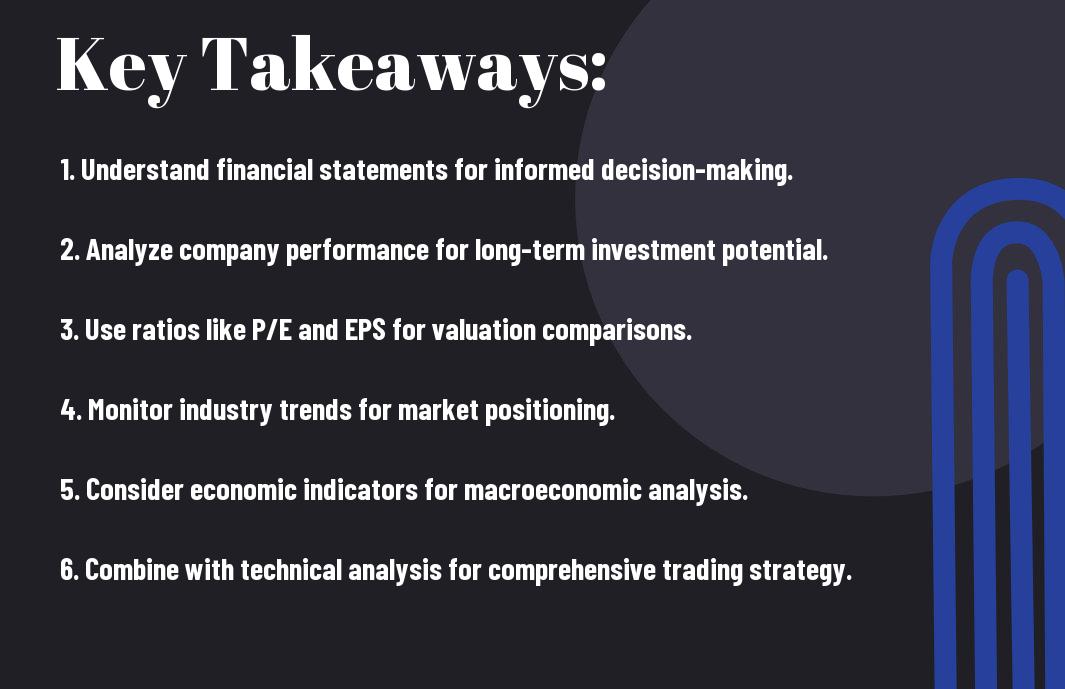Just like Benjamin Graham, you can enhance your market trading tools by incorporating fundamental analysis into your strategy. By understanding the underlying financial health and performance of a company, you can make more informed decisions when buying or selling stocks. Let’s explore how you can integrate fundamental analysis into your trading tools to achieve greater success in the market.
Key Takeaways:
- Fundamental analysis provides a comprehensive view: Incorporating fundamental analysis into market trading tools enables traders to have a deeper understanding of a company’s financial health, competitive positioning, industry trends, and macroeconomic factors.
- Integration with technical analysis for decision-making: By combining fundamental analysis with technical analysis, traders can make more informed decisions on entry and exit points, as well as risk management strategies, optimizing their trading outcomes.
- Regular updating and monitoring are crucial: Market trading tools should include mechanisms for regularly updating fundamental data and monitoring key metrics to adapt to changing market conditions and adjust trading strategies accordingly.
Fundamentals of Fundamental Analysis
Definition and Principles
For a detailed understanding of the fundamentals of fundamental analysis, you can refer to Fundamental Analysis: Principles, Types, and How to Use It. Fundamental analysis involves evaluating the intrinsic value of an asset by examining related economic, financial, and qualitative factors. This analysis seeks to determine the fair value of a security or investment and make investment decisions based on this assessment.
Importance in Market Trading
For market trading, fundamental analysis plays a crucial role in helping you make informed decisions about buying or selling securities. By analyzing financial statements, economic indicators, company performance, and industry trends, you can assess the value of an asset relative to its market price. Understanding the underlying fundamentals can give you a better perspective on market trends and make more strategic trades.
Analysis of fundamental factors allows you to gauge the financial health and growth potential of a company or asset. By considering factors such as earnings, revenue, debt levels, and competitive positioning, you can make more educated predictions about future price movements and identify investment opportunities that align with your financial goals.

Identifying Key Metrics
Financial Statement Analysis
To incorporate fundamental analysis into your market trading tools, you must start by analyzing a company’s financial statements. This involves examining the income statement, balance sheet, and cash flow statement to assess the financial health of the business. By reviewing these documents, you can gain insights into the company’s revenue, expenses, assets, liabilities, and cash flow.
Ratio Analysis
One way to incorporate fundamental analysis into your trading tools is through ratio analysis. Ratios such as price-to-earnings (P/E), debt-to-equity (D/E), and return on equity (ROE) can provide valuable information about a company’s performance and financial health. By comparing these ratios to industry averages or historical data, you can identify potential opportunities or risks in the market.
Financial ratios help you make more informed decisions by providing a deeper understanding of a company’s financial position. They can highlight trends, strengths, and weaknesses that may not be evident from simply looking at the financial statements.
Industry and Market Analysis
Market analysis involves examining broader market trends, such as economic indicators, interest rates, and market momentum. Understanding these factors can help you make more strategic trading decisions and anticipate market movements. Industry analysis, on the other hand, focuses on the specific sector in which a company operates. By assessing industry trends, competition, and regulatory factors, you can better evaluate a company’s position within its industry.
Industry and market analysis provide you with a comprehensive view of the external factors that can impact a company’s performance. By incorporating this analysis into your trading tools, you can enhance your ability to predict market trends and make more informed investment decisions.

Integrating Fundamental Analysis into Trading Tools
Charting and Visualization
One way fundamental analysis can be incorporated into trading tools is through charting and visualization. By including fundamental data points such as earnings, revenue growth, and valuation metrics on price charts, you can gain a more comprehensive understanding of a stock’s performance and potential value.
Algorithmic Trading
Into algorithmic trading systems, fundamental analysis can be integrated to automatically execute trades based on predefined fundamental criteria. These algorithms can be programmed to analyze financial statements, economic indicators, and other fundamental data to make informed trading decisions.
Algorithmic trading is a powerful tool that can help you take advantage of opportunities in the market based on fundamental analysis without emotional bias or human error.
Sentiment Analysis
The incorporation of sentiment analysis into trading tools can also enhance the effectiveness of fundamental analysis. By analyzing social media sentiment, news articles, and other sources of market sentiment, you can better gauge market sentiment towards a particular stock or sector.
To further refine sentiment analysis, natural language processing techniques can be employed to extract and analyze sentiment from news articles, earnings call transcripts, and other textual data sources.
Technical Indicators and Fundamental Analysis
Once again, when it comes to incorporating fundamental analysis into your market trading tools, it’s important to understand how technical indicators can complement this approach. Technical indicators can help you make sense of the data from fundamental analysis and aid in making informed trading decisions.
Moving Averages and Trend Identification
Any successful trader knows the significance of moving averages in trend identification. By incorporating moving averages into your analysis, you can better understand the direction in which a stock or market is moving. This can be particularly useful when combined with fundamental analysis to confirm or contradict trends identified through company data.
Oscillators and Momentum Indicators
Technical traders often rely on oscillators and momentum indicators to gauge the speed and strength of price movements. These tools can be beneficial in confirming potential trend reversals identified through fundamental analysis. By using oscillators such as the Relative Strength Index (RSI) or the Moving Average Convergence Divergence (MACD), you can add a layer of confirmation to your trading decisions.
Technical analysis is not meant to replace fundamental analysis but rather to complement it. Oscillators and momentum indicators can provide valuable insights into the timing of your trades, helping you execute buy or sell orders at optimal entry and exit points.
Volume and Open Interest Analysis
To further enhance your understanding of market trends and investor sentiment, incorporating volume and open interest analysis is vital. Monitoring the volume of trades can indicate the level of market participation and validate trends identified through fundamental analysis. Similarly, analyzing open interest in options contracts can provide insights into potential future price movements.
Interest in Volume and Open Interest Analysis can help you confirm or adjust your trading strategies based on the level of market activity and the number of participants involved.
Risk Management and Position Sizing
Unlike technical analysis, fundamental analysis can help you with risk management and position sizing in your market trading tools. By understanding the intrinsic value of a security, you can make more informed decisions about how much to invest and when to exit a position.
Stop-Loss and Risk-Reward Ratios
The key to successful trading is managing your risks effectively. Setting stop-loss orders based on fundamental analysis can help you limit your losses and protect your capital. Additionally, calculating risk-reward ratios using fundamental data can guide you in identifying profitable opportunities while minimizing potential downside.
Portfolio Optimization and Diversification
Optimization of your portfolio using fundamental analysis involves diversifying across different asset classes, industries, and geographies. By spreading your investments, you can reduce the overall risk of your portfolio while potentially increasing returns.
Furthermore, diversification based on fundamental factors such as company financials, management quality, and industry outlook can help you weather market fluctuations and uncertainties.
Market Timing and Entry/Exit Strategies
One way fundamental analysis can be incorporated into your market trading tools is through market timing and entry/exit strategies. By analyzing economic indicators, industry trends, and company performance, you can better time your trades and optimize your entry and exit points.
This strategic approach can help you capitalize on undervalued opportunities and avoid overvalued assets, enhancing your overall trading performance.

Real-World Applications and Examples
Value Investing and Contrarian Strategies
Examples of incorporating fundamental analysis into market trading tools for value investing and contrarian strategies include analyzing financial statements, cash flow statements, and earnings reports to identify undervalued stocks. By comparing the intrinsic value of a stock with its market price, you can make informed decisions on when to buy or sell. Contrarian investors, on the other hand, use fundamental analysis to identify stocks that are temporarily out of favor with the market but have strong underlying fundamentals.
Growth Investing and Momentum Strategies
Strategies that incorporate fundamental analysis for growth investing and momentum strategies focus on identifying companies with strong earnings growth potential. By analyzing factors such as revenue growth, market share, and industry trends, you can pinpoint stocks that have the potential to outperform the market over time. Momentum strategies, on the other hand, involve identifying stocks that have been trending upward and using fundamental analysis to determine if the momentum is sustainable.
The key to successful growth investing and momentum strategies is to look for companies with solid fundamentals and positive momentum indicators that signal continued growth potential.
Event-Driven and Special Situations Investing
Strategies that utilize fundamental analysis for event-driven and special situations investing involve analyzing corporate events such as mergers, acquisitions, spin-offs, or restructurings. By examining the impact of these events on a company’s financial health and valuation, you can make informed trading decisions. Special situations investing involves identifying undervalued opportunities in companies facing unique circumstances such as regulatory changes or management shake-ups.
Another key aspect of event-driven and special situations investing is evaluating the potential risks and rewards associated with these events and making decisions based on a thorough analysis of the company’s fundamentals.
To wrap up
On the whole, incorporating fundamental analysis into your market trading tools can provide you with a deeper understanding of the companies you are investing in. By focusing on factors such as financial statements, industry trends, and management team, you can make more informed decisions that align with your investment goals. If you are looking to dive deeper into fundamental analysis and its importance in trading, consider exploring the article Fundamental Analysis: Unlocking Investment Value for further insights and guidance.
FAQ
Q: How can fundamental analysis be incorporated into market trading tools?
A: Fundamental analysis can be incorporated into market trading tools by utilizing data on a company’s financial health, management team, competitive advantages, industry outlook, and overall market conditions. This information can be used to make informed decisions about when to buy or sell stocks, bonds, or other assets.
Q: What are some common market trading tools that incorporate fundamental analysis?
A: Some common market trading tools that incorporate fundamental analysis include financial news sources, stock screeners, research reports, economic indicators, earnings reports, and valuation models. These tools provide traders with the information they need to assess the intrinsic value of an asset and make investment decisions accordingly.
Q: How can traders effectively use fundamental analysis in conjunction with technical analysis?
A: Traders can effectively use fundamental analysis in conjunction with technical analysis by combining information about a company’s financial health and market conditions with data on price trends and trading volumes. By using both types of analysis together, traders can gain a more comprehensive understanding of an asset’s true value and make more informed trading decisions.


